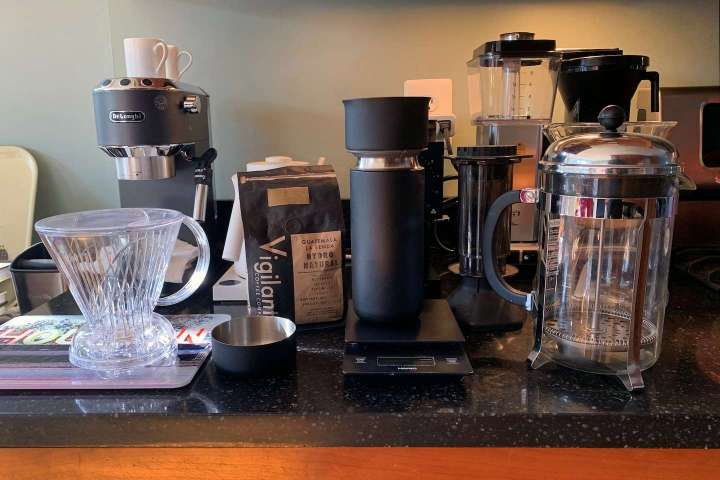The body of knowledge around coffee seems to grow exponentially every year, as the industry continues to roll out new brewers (sometimes to fix a problem created by a brewer from the prehistoric era of, say, 2005) or just develops more gadgets to separate coffee geeks from their money. (One peek into my kitchen cabinets, and you can tell who’s a sucker for gadgetry.)
How to make better coffee, whether pour-over, cold brew or Keurig

But here’s the thing about gadgets: No Japanese Origami dripper, no sleek high-tech grinder, no pouring tool and no temperature-controlled goose-neck kettle can overcome a batch of inferior beans. As James Hoffmann, managing director of Square Mile Coffee Roasters in East London and a general authority on the subject, writes in his latest volume, “The Best Coffee at Home”: Depending on your method, you should use beans four to five days after they’ve been roasted (for filter coffee) or seven to eight days after the roast (for espresso). But either way, once you’ve opened the bag, you should plan to use it up within two weeks.
It’s safe to say, you won’t consistently find these kind of freshly roasted beans at supermarkets, even at Whole Foods. Which is why you need to frequent, and befriend the team, at your local roastery. They’ll make sure you start with the freshest beans, often sourced from small farms or collectives that have developed close relationships with roasters.
Over the years, I’ve written a lot about brewing coffee at home and my relationship with the drink. As we head into the cooler months, I thought it would a good time to collect these articles on a single page, for easy reference if nothing else.
My knowledge, like the industry’s, has evolved, which is just another way of saying that I might approach some of these stories differently in 2022. But I think they still give you an idea of how different brewers, techniques, beans, water temperatures, roast levels and more can affect what you taste in the cup.
The stories may not change how you brew coffee at home, and that’s cool. If I’ve learned one thing about coffee over the years, it’s this: People love to fight for their right to enjoy a dark-roast blend that’s been reduced to mud after an hour on the warming plate of a Mr. Coffee.
And you know what? They’re right. Coffee is one of the most personal things you consume, day in and day out. It should be prepared just as you like it.
How to brew better coffee at home and save money in 5 easy steps: You don’t have to be a barista to make better coffee. With just a small investment in equipment — you don’t need a scale or thermometer! — and a little bit of time, you can turn your morning cup into something appreciably better than what you can make from a cheap drip coffee maker or a Keurig.
How to hack your Keurig machine and get a better cup of coffee: Speaking of the Keurig, the popular push-bottom brewer may be anathema to specialty-coffee snobs, but, as we discover, you can improve the machine’s performance with a few important alterations.
I thought cold brew coffee wasn’t worth a hill of beans until I used the right ones: Cold brew is a divisive subject among coffee lovers for one reason: Steeping ground beans in cold (or room temperature) water doesn’t extract the same flavors as steeping them in hot water. The cold-brew process produces a cup that’s sweeter and rounder, for sure, but usually at the expense of acids and other flavor compounds that give coffee depth and balance. These two recipes, however, produce a coffee that has more complexity than your typical cold brew.
Each coffee brewing method has pros and cons. We tried 5 to help you find your perfect cup. No two coffee brewers are alike, even when using the same beans. Each will extract different flavors. Each will result in a different viscosity, or weight, which you can sense on the tongue. Which is why it’s important to find the brewer that best suits your tastes. (By the way, if you’re curious, Mia Farrow went with the Chemex.)
How to make an excellent coffee pour-over and start your day right: Do you consider making coffee by hand a hassle? This streamlined recipe delivers many of the benefits of pour-over coffee without all the equipment and fuss. The recipe also suggests you can treat the morning ritual more like a meditation, one that results in a stimulant, the perfect combination to start any day.
Coffee at home: Experiments in brewing. You might wonder why there are so many coffee brewers on the market, some that require no skill and some that take weeks to master. We take you through the pros and cons of nine brewing systems, whether a French press or a cool Japanese siphon that requires a small butane burner. You might find one that aligns with your daily habits and needs.
Coffee is not just a drug to make us good worker bees. It’s a pleasure. No matter how you brew coffee, you shouldn’t treat the drink as if its sole purpose is to prepare you for another day on the hamster wheel. Kick back. Hold a warm cup between your hands. Enjoy it for what it is: One of life’s great pleasures.






